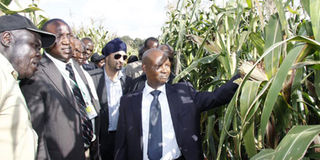Breaking News: At least 10 feared to have drowned in Makueni river
100,000 legume farmers needed to meet India demand

Eastern Africa Grain Council (EAGC) executive director, Gerald masila (in glassses) with Governor, Nakuru county Kinuthia Mbugua (Right) holding a maize cob with Kenya Seed's,Charles Nyakiogora. EAGC is recruiting over 100,000 growers to raise production to meet the volumes that India wants to import from Kenya. PHOTO | FILE
What you need to know:
- The Asian country is seeking to import 4 million tonnes of assorted legumes that comprise dry beans, cowpeas, pigeon peas and green grams.
- EAGC executive director Gerald Masila said the move is aimed at benefiting farmers by tapping on the latest technology to improve their productivity per acre.
- Pulses are the major source of protein for vegetarian Indians, and protein content in most of the pulses is more than one-fifth by their weight.
A regional body is seeking to raise production of legumes to meet a growing demand in India.
Eastern Africa Grain Council (EAGC) is recruiting over 100,000 growers to raise production to meet the volumes that India wants to import from Kenya.
EAGC is working with the International Trade Centre (ITC) to support farmers in producing and exporting their crops to India where there are shortages.
Under the Supporting India Trade and Investments with Africa (Sita) programme, Kenyan farmers will get financial and technical support as well as reduction of tariff barriers over three years.
The Asian country is seeking to import 4 million tonnes of assorted legumes that comprise dry beans, cowpeas, pigeon peas and green grams.
EAGC executive director Gerald Masila said the move is aimed at benefiting farmers by tapping on the latest technology to improve their productivity per acre.
“We will be working with over 100,00 farmers that we intend to train on the latest technology to increase their yields in order to meet the ready market demand in India,” said Mr Masila.
VEGETARIAN DIET
Mr Masila noted that production of legumes in the country is lower than the world’s average as well as the quantities that other regional countries are producing.
In 2013, Kenya produced 757,000 tonnes of legumes compared to the neighbouring Tanzania that harvested 1.5 million tonnes.
Farmers stand to benefit from this project given the fact that all grains to India are exempted from duty.
In Kenya, peas are mainly grown in eastern part of the country comprising Meru, Embu, Mbeere, Kitui, Machakos and Makueni. But Mr Masila says they would introduce the crop in all parts of the country in order to attain the required volumes.
According to Food and Agriculture Organisation (FAO), Kenya is placed at position 17 on the list of the world top legume producers with 760,000 tonnes annually, compared to the world’s largest producers with 18,000,000 tonnes.
In Africa, Kenya is positioned at number four after Nigeria, Tanzania and Ethiopia.
India is the biggest producer, consumer and importer of legumes in the world but part of their crop was destroyed by rains this year.
Pulses are the major source of protein for vegetarian Indians, and protein content in most of the pulses is more than one-fifth by their weight.
A regional body is seeking to raise production of legumes to meet a growing demand in India.
Eastern Africa Grain Council (EAGC) is recruiting over 100,000 growers to raise production to meet the volumes that India wants to import from Kenya.
EAGC is working with the International Trade Centre (ITC) to support farmers in producing and exporting their crops to India where there are shortages.
Under the Supporting India Trade and Investments with Africa (Sita) programme, Kenyan farmers will get financial and technical support as well as reduction of tariff barriers over three years.
The Asian country is seeking to import 4 million tonnes of assorted legumes that comprise dry beans, cowpeas, pigeon peas and green grams.
TOP PRODUCER
EAGC executive director Gerald Masila said the move is aimed at benefiting farmers by tapping on the latest technology to improve their productivity per acre.
“We will be working with over 100,00 farmers that we intend to train on the latest technology to increase their yields in order to meet the ready market demand in India,” said Mr Masila.
Mr Masila noted that production of legumes in the country is lower than the world’s average as well as the quantities that other regional countries are producing.
In 2013, Kenya produced 757,000 tonnes of legumes compared to the neighbouring Tanzania that harvested 1.5 million tonnes.
Farmers stand to benefit from this project given the fact that all grains to India are exempted from duty.
In Kenya, peas are mainly grown in eastern part of the country comprising Meru, Embu, Mbeere, Kitui, Machakos and Makueni. But Mr Masila says they would introduce the crop in all parts of the country in order to attain the required volumes.
According to Food and Agriculture Organisation (FAO), Kenya is placed at position 17 on the list of the world top legume producers with 760,000 tonnes annually, compared to the world’s largest producers with 18,000,000 tonnes.
In Africa, Kenya is positioned at number four after Nigeria, Tanzania and Ethiopia.
India is the biggest producer, consumer and importer of legumes in the world but part of their crop was destroyed by rains this year.





